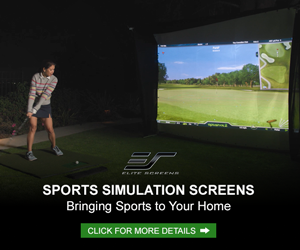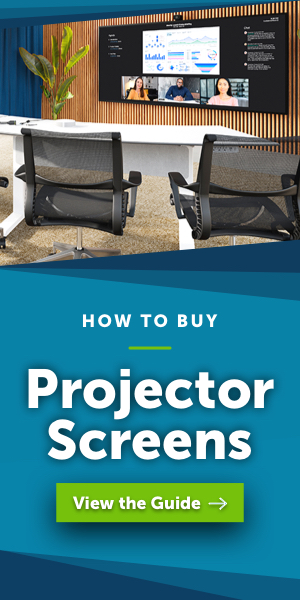The BenQ LH730 is a solid-state LED 1080p projector ideal for business and education, easily finding a home in K-12 classrooms, conference rooms, and boardrooms. The projector is maintenance-free thanks to its sealed light engine, it accepts 4K content, and despite measuring short of its claimed 4,000 ANSI lumens, it remains a nicely bright, affordable option for school districts to outfit their classrooms with, or businesses looking to buy multiple projectors.
- Maintenance-free LED light engine
- Wide Rec.709 color gamut with 4K HDR and HLG support
- Low input lag
- Falls short of its claimed 4,000 ANSI lumens with real content
- Requires optional Wi-Fi dongle to use wireless features
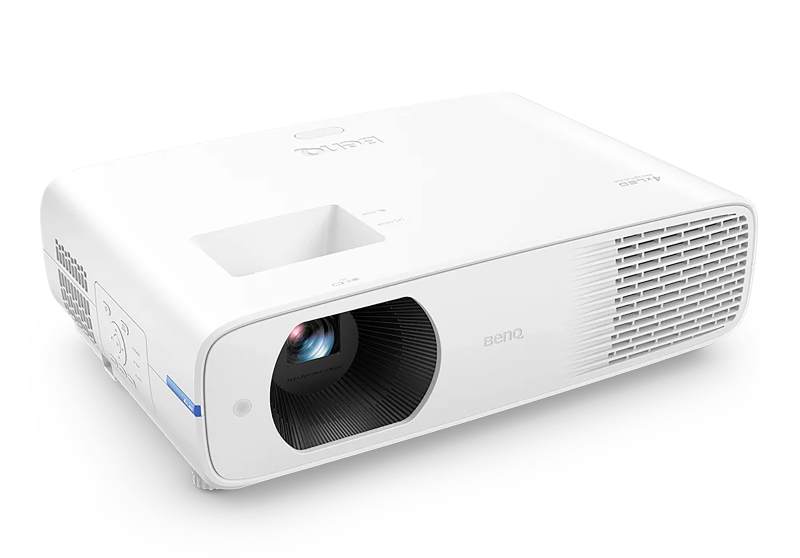
The BenQ LH730 is powered by a solid-state 4LED light engine. BenQ specifies 4,000 ANSI lumens, which is high for an LED light source in today's market. Though it falls well short of this claim in real-world conditions (more on that below), it remains more than bright enough for a variety of installations and, at its nice, low $1,299 street price, is unusually inexpensive for a projector with its benefits. Due to its sealed light engine, the projector is maintenance-free, and it has a lifespan of up to 30,000 hours. Projectors like this are of good value to school districts and businesses that plan to use their projectors heavily, as the lifetime cost of owning the projector will be incredibly low.
LED projectors tend to have a higher upfront cost than their lamp-based counterparts, which need their lamps replaced every 3,000-10,000 hours or so, as well as filters that need to get replaced over the span of their lifetimes. In the case of this BenQ, even after considering the savings from foregoing lamp replacements and the labor associated with filter maintenance, even the upfront cost is low, making it one to consider for business and education applications. The BenQ is bright enough to handle quite a bit of ambient light in its brightest picture mode, and can also perform in more moderate ambient light in all other color modes. It also has decent color out of the box in all but its brightest picture mode.
In terms of direct competition, the BenQ LH730 is going head-to-head with a projector I recently reviewed—the ViewSonic LS610HDH. That projector is also driven by a maintenance free LED light engine, and though it is spec'd similarly at 4,000 ANSI lumens, it also well fell short of its claim. The LS610HDH has a wider color gamut than this BenQ, and they share many of the same features including a 1.2X zoom lens. The BenQ does have a nice digital shift that aids in installation, a few small differences in inputs, and one more option for command and control than the ViewSonic. The LS610HDH street price is currently $1,100 at most resellers, so it costs about $200 less. The two projectors have the same input lag measurement, so if gaming is part of your applications, either will work well for you.
The BenQ LH730 is compact, making it a projector that can be taken from classroom to classroom, conference to conference room, with ease. It has a 3-year parts and labor warranty.
Features
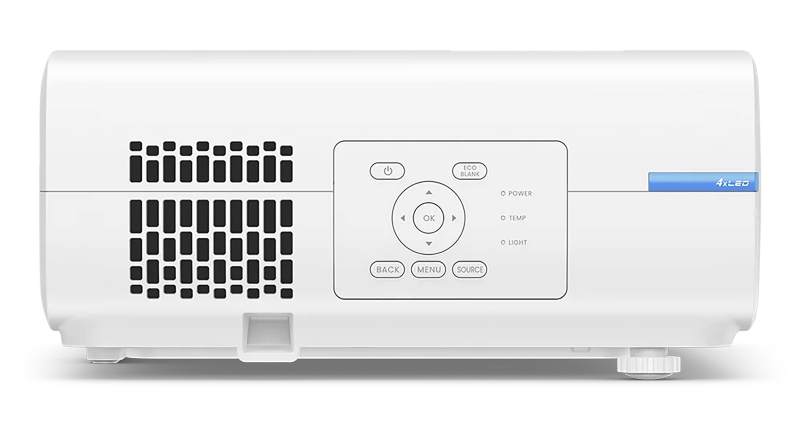
As with the recently tested and similar ViewSonic LS610HDH, the BenQ LH730 will come close to meeting its 4,000 ANSI lumen claim, but only when fed a very specific white-pattern test signal that causes the projector to enter into a hidden, high-output condition. Under these conditions the BenQ reaches 3,889 ANSI lumens in its brightest picture mode, labeled Bright. This was the brighter number from two samples we measured. However, this special mode will never be engaged in real use, and the full brightness that can be brought to bear on active content in the Bright picture mode is 3,289 ANSI lumens. This is just inside the accepted 20% tolerance dictated by the current ISO21118 measurement standard, though well below the advertised brightness. You can find more details in the Measurements appendix of this review.
Nonetheless, at its affordable price of $1,299 this BenQ offers a decent picture, great features, and what is still a good amount of brightness. It also offers a claimed 98% of the Rec.709 color space for good color fidelity, a strong feature given that many commercial projectors make no claim at all for color gamut. It is a 1080p projector that accepts 4K content and is compatible with 4K HDR10 and HLG high dynamic range content, which gets downscaled to the projector's native resolution. As mentioned, this is an LED projector, so there are no lamps to change, and that's one of its key selling points—it's maintenance-free. Thanks to the sealed light engine that keeps dust and moisture out of the optics, the total cost of ownership over time is lower than many lamp-based projectors, and with such a low upfront cost, it's definitely one to consider.
This DLP projector's LED light engine lasts up to 30,000 hours in Eco mode, and BenQ guarantees 20,000 hours at full power. The projector is designed to run 24/7, making it ideal for classrooms, conference rooms, retail, and even museum applications. With Instant On/Off, the LH730 is plug and play, and there's no worry of damaging the projector if you turn it off and turn it back on too quickly. There is no "too quickly" with the LH730.
The LH730 supports 3D and BenQ has optional 3D glasses (DGD5) for use with 3D content. The projector has relatively low input lag, too, coming in around 33 milliseconds. So if you're looking to use the projector for a virtual gaming experience in a retail environment, it has the chops to deliver.
Installation is simple, and BenQ meant it to be. The LH730 has a sharp, manual 1.2X zoom lens. It features auto vertical keystone correction, and horizontal keystone correction. The geometric correction goes a step further with Corner Fit control, allowing you to adjust each corner of the projected image.
Digital Image Shrink is a useful feature for installation, shrinking down the image to fit the screen if that's necessary for your space. It has Digital Shift, which acts like lens shift, moving the image horizontally or vertically, but it only works if you've shrunk the image. The aspect ratio is auto detected. There are three options in the menu to choose from manually: 4:3, 16:9, 16:10. All of these features work together to ensure the prime positioning of the projector in your space. To find out the throw distance for your screen size, check out our BenQ LH730 Throw Distance Calculator.
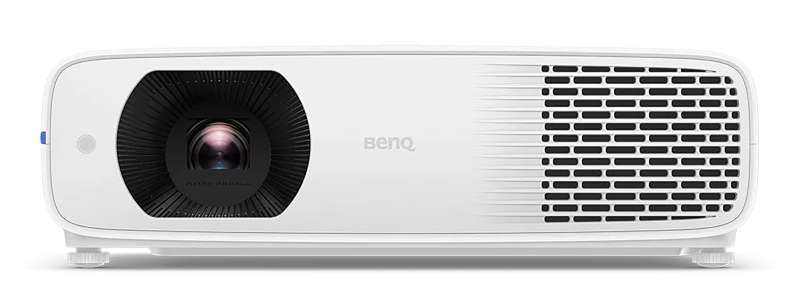
The projector has a 10-watt mono speaker. The speaker is good. It's loud and clear. At full volume, it can fill a large K-12 or college classroom, perhaps even larger than that. It was actually a bit too loud at full volume in my space, which is a large open concept apartment in that main room. I was impressed that I had to turn it down. There's not much in the way of bass, as to be expected, but there is more bass than some other on-board speakers, so I would say it is among the better ones. You do get a 3.5 mm Audio Out jack to hook up external speakers for louder, more spacious sound. Most applications will not require this, but the option is there should you require it.
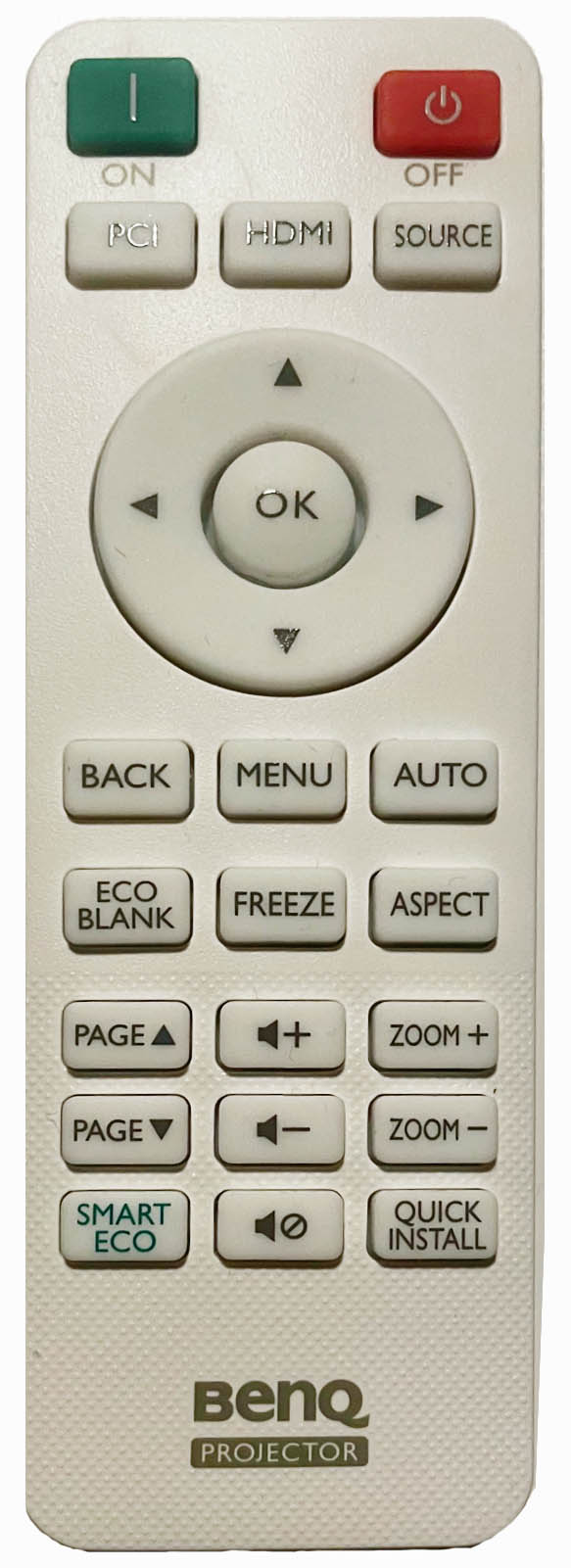
The BenQ's remote control is small and lightweight. It doesn't have a backlight, but it's white and easy enough to see in a moderately dark room. The top of the remote has an On button on the left, and Off on the right. Under that are three buttons: PC1, HDMI, and Source. This allows you two quick select the most-used inputs, and otherwise toggle Source inputs. Below that are the usual navigational arrows and OK button, and Back, Menu, and an unused Auto button under that. Underneath is ECO Blank, Freeze, Aspect. ECO Blank hides the image (never block the lens with an object, this can cause a fire), Freeze freezes the projected image, and Aspect changes the aspect ratio. The final sets of buttons include Page +/-, Volume +/-, Zoom +/, Smart ECO, Mute, and Quick Install.
In terms of hardware connections, the BenQ has everything you need for typical business and education applications located on the back of the projector. There are two HDMI inputs, both are HDCP 2.2; a USB Type-A port for the optional wireless dongle (EZC5201BS)—which I did not get to test out with this review unit; a second USB Type-A service port, an audio out jack, an RJ-45 Ethernet port for wire network connections, and an RS232 port for old school command-and-control. A control panel is on the right side, with the usual navigational buttons surrounding an OK, Back, Menu, and Source buttons below, and the Power and Eco/Blank buttons above.
I did not like that there is a need for a Wi-Fi dongle to use the wireless features on this projector, or that the dongle, EZCast model EZC5201BS, does not ship with the unit. Though it's not the end of the world, many projectors now have this ability built-in; there are sub-$500 pico projectors today that you can wirelessly connect to without the use of a dongle. So the lack of Wi-Fi is something of an omission, particularly for a classroom or conference room projector where it's expected that users may need to connect their personal devices on a regular basis. Since I did not have the dongle, there was a screen that popped up every time I used the projector telling me that I didn't have the wireless dongle installed, though you can turn off reminders in the Menu Settings menu.
The projector works with Crestron, AMX, PJ Link and BenQ's DMS Local for centralized command and control. BenQ's proprietary software works with Windows OS and allows for integration of your DMS Local settings with the DMS Cloud via Agent Mode. The LH730 is compatible with both Mac and PC. Furthermore, it works with an adapter on MacBooks for the HDMI input, which not all Mac compatible projectors do—some only play nice with a direct HDMI-to-HDMI link between the projector and computer.
Performance
Color Modes. There are seven color modes offered by the BenQ LH730: Bright, Presentation, Spreadsheet, Video Conference, Inforgraphic, User 1, and User 2. In addition, the projector will launch into its 3D mode when it sees a 3D signal, or into either a dedicated HDR10 or HLG mode when it recognizes HDR metadata of each type.
The projector has robust controls for adjusting the picture beyond the usual brightness, contrast, etc. These include basic and refined color temperature controls (RGB Gain and Bias) for white balance, and a CMS for fine tuning the RGBCMY color points for Hue, Saturation, and Gain. There's also a multipoint gamma control for adjusting the image for different lighting conditions or content, and an adjustable HDR Brightness control. This projector already has decent color right out of the box, so being able to adjust color in this capacity provides the ability to get even more accurate color with some modest tweaking.
Not surprisingly, Bright mode, the projector's brightest, is a sort of muddy green. It turns people into goblins. The model on my test sheet is fair but tan, with golden blond hair and one hazel eye, one blue. The hazel eye looks brown, the blue looks grey. Her hair looks like she swam too much in an old school swimming pool and her skin is super green. Far worse than how one looks standing under your average fluorescent light. As for the color wheel I display to check color accuracy, everything looks muddy. There's not a color on there that looks how you'd want it to if presenting a graphic presentation or watching videos.
Therefore, stay away from Bright if you can swing it—this is truly a break-glass-in-case-of-emergency mode. If you do need its extra brightness, you'll want to utilize the CMS and tweak the color as much as you can. Play with blues and magentas, getting rid of greens and yellows as the forefront colors and balancing them out.
Presentation mode has some heavy blue, which brings out the whites nice and bright, as well as that model's blue eye on my test sheet. Skin tones look good, too. This mode has more focus on the magenta, blue, and green side of the color wheel, but the greens look like a deep turquoise or solid green crayon color. It will be ideal for presentations, especially where you have many colors intermingled with text, and any skin tones.
Spreadsheet mode is similar to Presentation mode but the skin tones don't look as natural, rather washed out like they might look under artificial lighting, and a bit desaturated. Colors aren't as bright and vibrant as they are with Presentation. Aptly named, this mode is best for spreadsheets and documents where the primary colors are black and white. White backgrounds are clear.
Video Conference mode gives this rosey tint over skin tones that would look good over Zoom, Skype, and Google Meetup calls. The magenta, purple, and blues are desaturated, so it's not true to color, and overall, there is a bit of desaturation to the color mode. Sometimes, desaturation helps with things like hiding blemishes and shine, which can show up via webcam, so this mode may help with that and provide a good-looking image. Red and red orange are not distinguishable from each other.
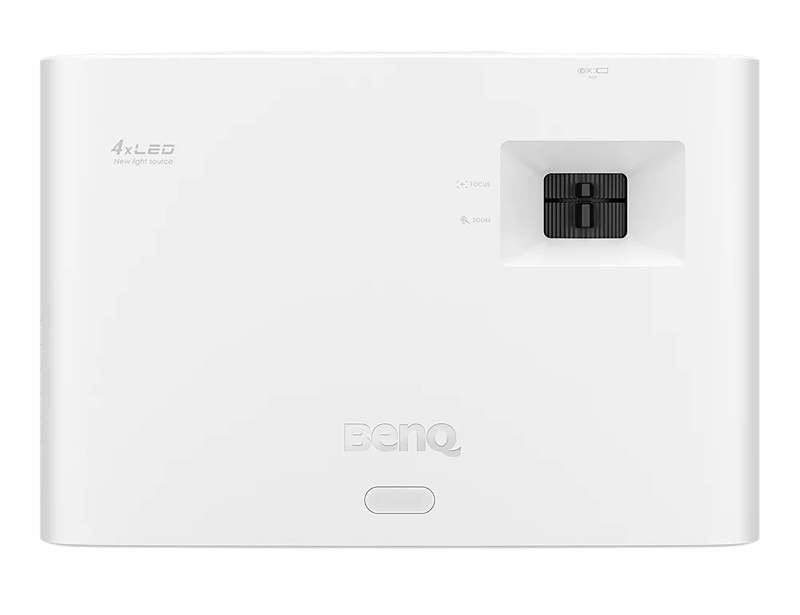
Infographic mode is nearly the same mode as Presentation, only Presentation is more vibrant. Otherwise it's almost indistinguishable. The colors are pretty on point, though a tad desaturated. It's a good mode that does well on skin tones as well as presentations and infographics, making it versatile.
User 1 mode and User 2 mode start off looking just like Presentation, and you can change them to your liking using the advanced color management system in the menu.
Presentation Viewing. The BenQ LH730 can present content by connecting a computer to the projector via HDMI or wirelessly using the optional wireless dongle (sold separately). As it works with both Mac and PC, the projector is suitable for classrooms and conference rooms where multiple presenters may bring their own devices to present with, and compatibility will never be an issue.
Irrespective of picture mode, I found that smaller 8-point and 10-point fonts were not really readable from 15 feet back. Things start getting legible with 12-point lettering, while 16 points, and so on, are of course better. There are no issues with color choices—for example, yellow font on blue background or white font on yellow background. This is good; some projectors have issues with these kinds of difficult type combinations that come up occasionally. The Presentation, Spreadsheet, and Infographic modes all had the same results and are highly usable for presentations.
How do you choose the right screen for your projector?
Our Projector Screen Buyer's Guide will take you through the process of finding the correct screen for your projector and space.
Screen Buyer's Guide
When it comes to presentations, infographics, and spreadsheets, the modes that are named for them don't do anything special beyond altering the color balance. You'll find that Presentation and Infographic will be the most true-to-color modes available to you, so choose which you like best. Spreadsheet is the brightest of these three modes, but only by a touch. Presentation and Infographic measured within 50 lumens of each other.
That said, I chose Presentation as the best mode for presentations and infographics. It's the brightest of the two modes listed above and looks better than Spreadsheet. Consistently, I liked the way it handled color and text through a variety of presentation slides, infographics, websites, and even spreadsheets. But keep in mind that this BenQ offers many options for you to work with for your presentations, including those User Modes, which are worth checking out if you want to get even more true-to-color using the CMS.
Video Viewing. Since most 4K content comes mated with HDR10 encoding today, (and pretty much all HDR10 content is in 4K), the LH730H's HDR10 mode is likely the only color mode option for your 4K content. Fortunately, it looks great, even when downscaled to the projector's native 1080p resolution. Skin tones are natural, the colors that are meant to be vibrant are vibrant—like Leeloo's orange hair and Korben's orange shirt in The Fifth Element as seen from the 4K UHD Blu-ray. But like the skin tones, these colors look natural. Ghost in the Shell also looked good in terms of skin tones. It also has a lot of bright colors in city scenes that were handled well in HDR10, as well as dark scenes.
For 1080p video content, Video Conference is the best mode. Since it leans toward that magenta tone, it gives a nice, natural look to skins tones. You can also use Presentation, as it looks pleasant as well, but it has a bluer tone and it's evident when you switch between the two. The Fifth Element's colors are more vibrant on 1080p content. The 4K versions of these movies in HDR10 gives a lovely, more true-to-life feel, though Video Conference is still quite enjoyable and does look good. Ghost in the Shell in 1080p appeared brighter than it was in 4K, so if there's a lot of ambient light in your room environment, you may find that 1080p content works better for this reason alone. In terms of color, it looked good, with natural skin tones, bright and vibrant city colors, and decent dark shadow detail.
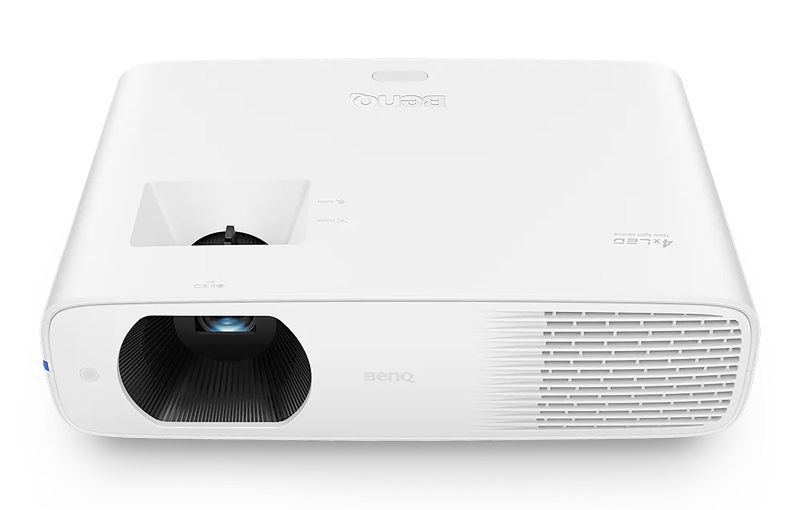
Black levels are decent for an entry-level projector, as is the dark shadow detail. For best results, darken the room environment as much as you can while watching video content, especially when the content itself has darker scenes. It's watchable in ambient light, but you lose dark shadow detail and black levels become a grey. Ghost in the Shell has a lot of dark scenes, for instance, and a film like that is better enjoyed in a darker setting whether you're projecting in 4K or 1080p. In any case, this projector can be used with a fair amount of ambient light present no matter what you're watching.
Conclusion
The BenQ LH730 is a bright LED business and education projector that is maintenance-free. Installation is easy, with a sharp, 1.2x manual zoom lens, auto vertical keystone correction and manual horizontal keystone correction, Corner Fit geometric correction, Digital Image Shrink and Digital Shift. It is compact and easy to move around from classroom to classroom, conference room to conference room, if there is a need to share the projector.
The LH730 has Instant On/Off and is guaranteed by BenQ to last 20,000 hours at full power, with a claim of 30,000 hours for Eco mode. There are networking features command and control, including the usual Crestron, AMX, PJ Link, and BenQ's own proprietary software.
Furthermore, this BenQ's out of the box color is decent in all modes, except Bright, which is to be expected. Although it failed to make its full ANSI lumen spec under normal viewing conditions, that mode, and even the others that all have better color, are bright enough to cut through a good amount of ambient light that would be present in most conference rooms or classrooms. The projector also has a robust color management system to further improve color. 4K content looked great, as well as 1080p content—each had their own merits.
With a 33.1ms input lag, the projector is good enough for gaming, so if that is one of your applications, this BenQ may be one to consider! The $1,299 BenQ is a good value for school districts, businesses, and even museums that are looking for a projector that accepts 4K content.
Measurements
Brightness. Editor's Note: Based on Nikki Kahl's unusually low brightness measurement results for our first sample of the BenQ LH730, we conducted a retest in ProjectorCentral's studio using our lab-grade Konica Minolta meters and a professional signal generator. When those results were ultimately verified, BenQ sent a second sample to ensure our first sample was not defective. It was not, though the second sample delivered marginally higher numbers which are quoted here. Otherwise, its behavior was the same.
As we found in our retesting of the recently reviewed ViewSonic LS610HDH—another LED business projector with largely the same specs and features, and a physically similar chassis—we discovered in the BenQ LH730 a hidden "turbo" mode that kicks in only when the projector is being tested for brightness. ANSI lumen measurements are based on a nine-point average of brightness across the full image as described in this article. The prescribed test pattern is a full-screen white frame delivered at the maximum video level 255, such as might be generated in a full range 0-to-255 video signal from a PC, versus the limited range 16-235 video level range typically output by traditional video sources such as disc players or set-top boxes.
As with the ViewSonic, when fed a white pattern at video level 255, the BenQ in its brightest video mode (Bright) will recognize the signal and within about 10 seconds suddenly increase its light output while powering up its fan to avoid overheating. In this state, our second sample measured 3,851 ANSI lumens, only slightly short of the full rated 4,000 ANSI lumen spec. Dropping the brightness of the white pattern an essentially negligible amount—to video level 251—brought the signal under the threshold to activate the LH730's turbo mode and the projector returned to its typical output for the Bright mode, where it reached 3,290 ANSI lumens. Technically, this is just within the 20% tolerance built into the current ISO21118 measurement specification that has essentially supplanted ANSI and uses the same measurement technique. However, it is approximately 13% less brightness than when the turbo measurement mode is active. Given that any introduction of active pixels in the signal brings the average picture level below the turbo mode threshold, the maximum usable ANSI brightness of the BenQ LH730 is about 3,300 lumens, though with the Bright picture mode's heavily green-tinted bias. This 3,300 ANSI lumens, rather than the 4,000 ANSI lumen claim, should be used when specifying this projector for installation where its full brightness is intended to be used. The output of the less bright and more color-accurate picture modes in our chart below are accurately reported.—Rob Sabin
The LH730's Normal (brightest) light power mode is the default for all measured modes except HDR10, which defaults to Smart Eco. Switching to the Eco mode results in an approximately 14% drop in brightness in any picture mode. Smart Eco is said to adjust the light source power automatically depending on the content brightness. In addition, the projector has a Custom option that allows a custom setting from 70% to 100% of full power.
Along with the seven SDR modes shown below the LH730 has dedicated picture modes that kick in automatically for HDR10 and HLG signals, and a 3D mode for 3D.
BenQ LH730 ANSI Lumens
| Mode | Normal | Eco |
|---|---|---|
| Bright | 3,290 | 2,829 |
| Presentation | 1,981 | 1,704 |
| Spreadsheet | 2,162 | 1,858 |
| Video Conference | 1,776 | 1,527 |
| Infographic | 1,974 | 1,698 |
| User 1 | 1,981 | 1,704 |
| User 2 | 1,981 | 1,704 |
| HDR10 | 1,829 | 1,573 |
Zoom Lens Light Loss. Shifting the BenQ LH730 from its widest to its longest zoom position results in a measured 6.7% reduction of light output.
Brightness Uniformity. The brightness uniformity of the BenQ LH730 in its wide zoom lens position was a relatively high 83.6%. There were no visible hot spots or dimming on the image when viewing presentations, websites, or video content.
Fan Noise. Standing approximately five feet in front of the table mounted projector in a quiet room, measuring a foot below it, the ratings were as follows: Normal—38.6 dBA, Eco—34.2 dBA, Smart Eco—38.4 dBA, Custom—38.5 dBA. In High Altitude mode, to be used at elevations above 1,500 meters (4,900 feet), it the noise rose as follows: Normal—43.9 d dBA, Eco—41.3 dBA, Smart Eco—43.8 d dBA, Custom—43.7 dBA.
Input Lag. BenQ claims 33.4ms input lag for 1080p signals @ 60Hz. I am pleased to report that it came in on target, with both 1080p and 4K signals @ 60Hz measuring at 33.1ms. Given that number, the LH730 would be just fine to play video games on if your applications called for it. Even competitive games would fare well, though hardcore gamers are always looking for the 16ms mark. As this is a business and education projector, there's no need for that, though—33.1ms is great for most situations.
Connections
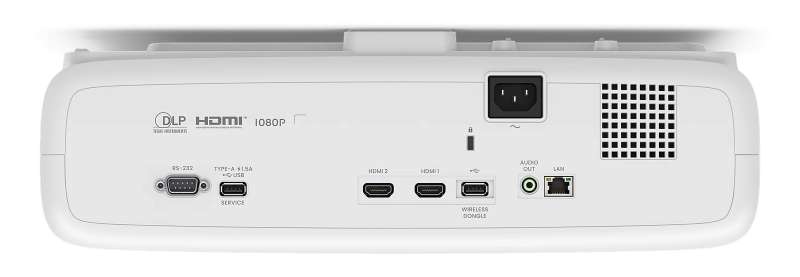
- LAN: RJ-45
- HDMI (x2, 2.0b/HDCP 2.2)
- Power Supply: USB Type A 2.0 (5V/1.5A Out)
- Power Supply/Wireless Dongle: USB Type A 2.0 (5V/1.5A Out)
- PC Control Port: RS232 (D-Sub 9pin)
- Audio Out: Stereo Mini Jack (3.5mm Mini Jack)
For more detailed specifications and connections, check out our BenQ LH730 projector page.
To buy this projector, use Where to Buy online, or get a price quote by email direct from Projector Central authorized dealers using our E-Z Quote tool.




